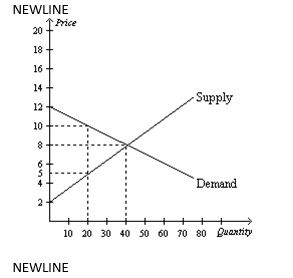Answer the following questions based on the graph that represents J.R.'s demand for ribs per week at Judy's Rib Shack.

a. At the equilibrium price, how many ribs would J.R. be willing to purchase?
b. How much is J.R. willing to pay for 20 ribs?
c. What is the magnitude of J.R.'s consumer surplus at the equilibrium price?
d. At the equilibrium price, how many ribs would Judy be willing to sell?
e. How high must the price of ribs be for Judy to supply 20 ribs to the market?
f. At the equilibrium price, what is the magnitude of total surplus in the market?
g. If the price of ribs rose to $10, what would happen to J.R.'s consumer surplus?
h. If the price of ribs fell to $5, what would happen to Judy's producer surplus?
i. Explain why the graph that is shown verifies the fact that the market equilibrium quantity) maximizes the sum of producer and consumer surplus.
Correct Answer:
Verified
b. $10.00
c. $80.00.
d. 40
e. $5
f...
View Answer
Unlock this answer now
Get Access to more Verified Answers free of charge
Q21: Connie can clean windows in large office
Q22: The lower the price, the lower the
Q40: The area below the price and above
Q42: Total surplus = Value to buyers -
Q44: If a market is in equilibrium, then
Q48: Even though participants in the economy are
Q51: Ticket scalping can increase total surplus in
Q69: When markets fail, public policy can potentially
Q75: In order to conclude that markets are
Q109: Answer each of the following questions about
Unlock this Answer For Free Now!
View this answer and more for free by performing one of the following actions

Scan the QR code to install the App and get 2 free unlocks

Unlock quizzes for free by uploading documents